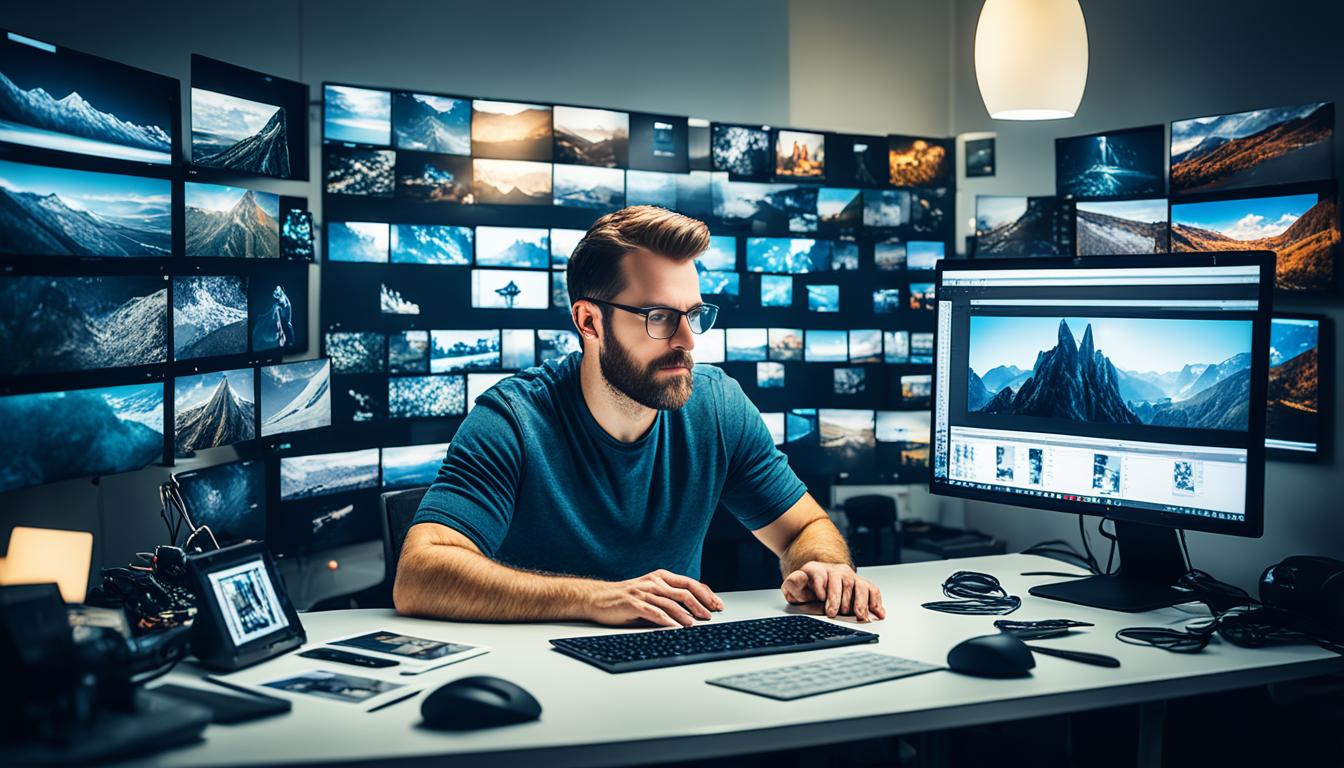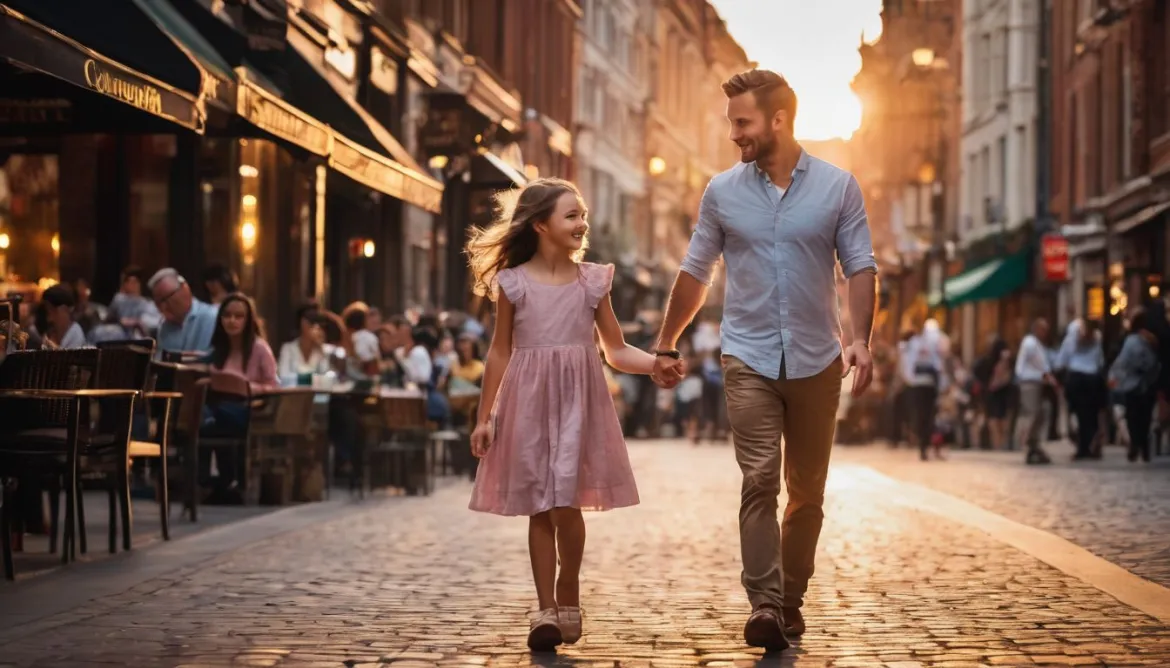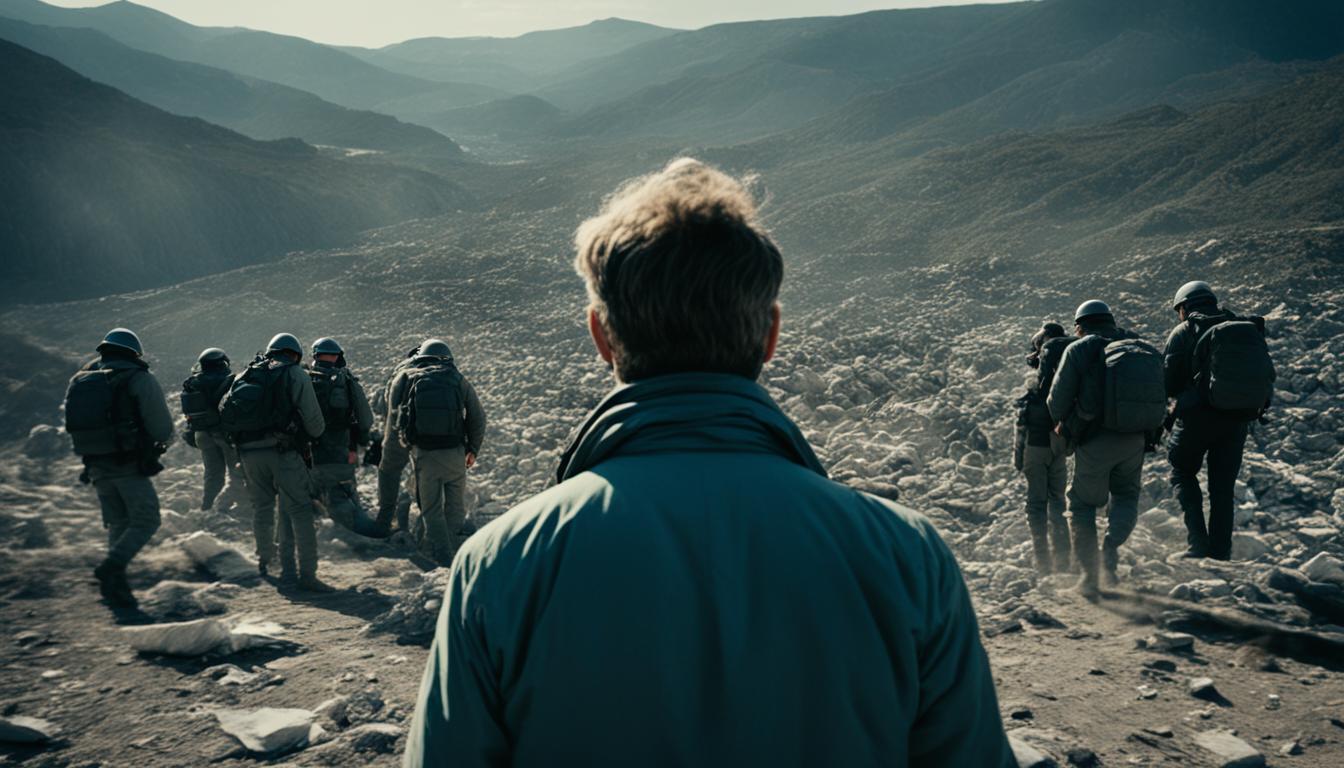Welcome to our guide on editing and sequencing photos for impactful narratives in visual storytelling. In the world of digital asset management, the power of visual storytelling in photo collections cannot be underestimated. Crafting a narrative through carefully sequenced images has the ability to captivate audiences and leave a lasting impact.
Visual storytelling has a unique ability to evoke emotions, convey messages, and transport viewers to another time or place. Whether you are a professional photographer or an enthusiast, understanding the art of image curation and photo sequence is key to creating compelling visuals that tell a story.
Editing and sequencing photos is a process that involves selecting the right images, arranging them in a logical order, and enhancing their overall impact through various photography editing techniques. In this guide, we will explore the importance of sequencing in photo collections, the key components of a narrative, establishing a narrative structure, selecting the right photos for storytelling, and using visual cues to enhance the narrative.
Key Takeaways:
- Editing and sequencing photos is crucial in creating impactful narratives in visual storytelling.
- Narrative photography combines the power of storytelling with compelling visuals to engage viewers.
- Sequencing photos in a logical order guides the viewer’s attention and enhances the storytelling experience.
- Key components of a narrative include theme, characters, plot, setting, and conflict/resolution.
- Establishing a narrative structure with a clear beginning, middle, and end is essential for a cohesive photo collection.
Importance of Sequencing in Photo Collections
Sequencing plays a crucial role in creating impactful narrative photo collections. It is the art of arranging photos in a specific order that enhances the overall story, guiding the viewer’s attention and evoking an emotional response. The careful selection and arrangement of images allow for a logical flow and establish a rhythm, enhancing the storytelling experience.
By sequencing photos in a deliberate manner, photographers can effectively communicate their intended message and create a compelling narrative that resonates with the audience. The sequencing determines the pacing of the story, ensuring that it unfolds at a suitable rhythm and engages the viewer throughout.
When sequencing a photo collection, it is essential to consider the narrative flow. Each photo should flow seamlessly into the next, creating a cohesive and immersive storytelling experience. The sequence should be thoughtfully planned, taking into account the context, subject matter, and emotional impact of each image.
Furthermore, sequencing allows photographers to establish a narrative arc, adding depth and dimension to the photo collection. It helps build anticipation, tension, and resolution, much like the structure of a traditional story. By strategically arranging the photos, photographers can guide the viewer through an emotional journey, captivating their attention and leaving a lasting impression.
The Emotional Impact of Sequencing
“Sequencing photos is like composing a symphony, where each image contributes to the overall harmony and emotional resonance of the narrative.”
The sequencing of photos has a profound impact on the emotional response of the audience. When images are arranged in a specific order, it creates a flow that can evoke various emotions and connect the viewer on a deeper level. The careful placement of photos can heighten suspense, evoke empathy, or elicit a sense of awe and wonder.
For example, in a photo collection capturing a wedding, the sequence might begin with candid shots of the couple preparing for their special day, followed by intimate moments during the ceremony, and concluding with joyful images of the celebration. This deliberate sequencing enhances the emotional experience, allowing the viewer to feel the anticipation, love, and happiness present throughout the event.
Sequencing also helps to maintain the viewer’s attention by creating a narrative flow. It establishes a rhythm that propels the story forward, encouraging the audience to continue engaging with the collection. When photos are sequenced thoughtfully, it becomes more than just a series of images; it becomes an immersive visual narrative that captivates and resonates with the viewer.
The Power of Visual Cues
Visual cues are essential tools in sequencing photo collections. They direct the viewer’s attention, guide the narrative flow, and emphasize important elements within each image. Leading lines, framing techniques, color contrasts, and other compositional elements can all be used strategically to enhance the storytelling experience.
For instance, leading lines can guide the viewer’s gaze from one photo to the next, creating a seamless transition between images. Framing techniques can draw attention to specific subjects or details, emphasizing their significance within the narrative. Color contrasts can evoke different moods and emotions, helping to accentuate the overall theme or message of the photo collection.
Key Components of a Narrative
A narrative is more than just a series of images. It is a story with a beginning, middle, and end. When crafting a narrative, we should consider several key components that contribute to its overall structure and impact.
- Theme: The theme is the overarching message or idea that the photos convey. It serves as the guiding principle behind the narrative, providing a sense of purpose and direction.
- Characters: Characters are the individuals or subjects featured in the photos. They are the key players who drive the narrative forward and create emotional connections with the viewers.
- Plot: The plot refers to the story or sequence of events that the photos illustrate. It encompasses the actions, conflicts, and resolutions that unfold throughout the narrative.
- Setting: The setting determines where and when the photos take place. It adds context and atmosphere to the narrative, helping to create a sense of time, place, and mood.
- Conflict/Resolution: Conflict refers to any problem or tension addressed in the photos, while resolution represents how that conflict is resolved. Conflict and resolution are essential for creating tension, emotional depth, and a sense of closure in the narrative.
By carefully considering these key components, photographers can construct a well-rounded and engaging narrative that resonates with viewers and leaves a lasting impression.
Establishing a Narrative Structure
Establishing a narrative structure is crucial when it comes to guiding the viewer through a photo collection. By creating a clear beginning, middle, and end, we can ensure a cohesive storytelling experience that captivates and resonates with our audience.
The journey begins with the opening photos, which serve as the gateway to our narrative. These carefully selected images should immediately capture the viewer’s attention and set the tone for the story that is about to unfold. Whether it’s a striking visual or an emotionally evocative shot, the opening photos create the initial connection and intrigue, paving the way for what’s to come.
As we move into the middle section of the narrative, we delve deeper into the story, introducing key elements and building anticipation. Here, we have the opportunity to expand on the initial intrigue and provide a deeper understanding of the subject matter. This is where we can introduce more complexity and nuance, keeping the viewer engaged and eager to discover what happens next.
Closing photos play a pivotal role in providing a sense of resolution and leaving a lasting impression on the viewer. These images serve as the culmination of the narrative, tying together loose ends and providing a satisfying conclusion. They should evoke emotions and leave the viewer with a sense of fulfillment, ensuring that the impact of the story lingers long after the last photo has been viewed.
By carefully establishing a narrative structure that encompasses a strong beginning, a captivating middle section, and a powerful ending, we can create a photo collection that tells a compelling story. Through the strategic use of opening photos, middle section development, and closing photos, we guide our viewers on an immersive journey that immerses them in our narrative and leaves a lasting impression.
Selecting the Right Photos for Storytelling
When it comes to creating a compelling narrative through photo sequencing, selecting the right photos is crucial. Each photo should contribute to the overall story and serve a specific purpose in enhancing the storytelling experience. Here are a few key considerations for choosing photos that will help you tell a cohesive and impactful story:
Composition:
Pay attention to the composition of your photos and how they work together as a collection. Consider elements such as balance, framing, and the placement of subjects within the frame. Well-composed photos can create a visually pleasing narrative that draws viewers in.
Lighting:
The lighting in your photos sets the mood and can greatly impact the storytelling. Experiment with different lighting techniques, whether it’s natural light, artificial light, or a combination of both. Be intentional with the lighting to evoke the desired emotions and enhance the narrative.
Subject Matter:
Choose photos that align with your intended narrative and theme. The subject matter should be relevant and meaningful, adding depth and resonance to the overall story. Consider the emotions and messages you want to convey through your chosen subjects.
“Selecting the right photos is like assembling the pieces of a puzzle. Each photo should fit seamlessly into the narrative, creating a cohesive and powerful story.” – [Author Name]
By carefully selecting photos that excel in composition, lighting, and subject matter, you can create a photo collection that tells a cohesive story. It’s the combination of these elements that contributes to an impactful narrative and engages viewers on a deeper level.

Using Visual Cues to Enhance the Narrative
Visual cues play a crucial role in guiding the viewer’s attention and creating an immersive storytelling experience. By incorporating leading lines, framing techniques, color contrasts, and other compositional elements, photographers can shape the narrative and engage the viewer on multiple levels.
Leading lines are powerful visual cues that draw the viewer’s gaze and guide them through the photo collection. Whether it’s a winding road, a row of trees, or a meandering river, these lines create a natural flow and invite the viewer to explore the narrative further. They add depth and dimension, creating a visual journey that keeps the viewer engaged.
Framing is another effective technique that can enhance the storytelling experience. By using elements within the frame to create a border or frame around the subject, photographers can direct attention and add context to the story. It can create a sense of intimacy or focus on specific details, guiding the viewer’s eyes to the intended focal point.
Color contrasts can also be used to evoke emotions and add visual interest to the narrative. Contrasting colors can create a sense of tension or highlight important elements within the photo collection. They can enhance the mood of the story and make the narrative more dynamic and impactful.
Compositional Elements for Storytelling
In addition to leading lines, framing, and color contrasts, there are several other compositional elements that photographers can utilize to enhance the narrative:
- Rule of thirds: By placing key elements along the intersecting lines or at the points of intersection within a photo, photographers can create a balanced composition that is visually pleasing.
- Foreground/background: By including elements in the foreground and background, photographers can add depth and provide context to the story.
- Symmetry: Symmetrical compositions can create a sense of harmony and balance in the narrative, drawing the viewer’s attention to the subject.
- Negative space: Negative space can be used strategically to create a sense of isolation or to emphasize the subject.
By harnessing the power of these visual cues and compositional elements, photographers can create a visually compelling and engaging narrative that resonates with viewers. Each element contributes to the overall storytelling experience, enhancing the impact and leaving a lasting impression on the audience.
| Visual Cue | Definition | Example |
|---|---|---|
| Leading Lines | Lines within a photograph that guide the viewer’s gaze and create a sense of movement and flow. | |
| Framing | Using elements within the frame to create a border or frame around the subject, directing attention and adding context. | |
| Color Contrasts | The use of contrasting colors to create visual interest, evoke emotions, and highlight important elements. |  |
| Rule of Thirds | Dividing the frame into thirds both horizontally and vertically, and placing key elements along the intersecting lines or at the points of intersection. |
Conclusion
In conclusion, the art of editing and sequencing photos plays a crucial role in creating impactful narratives and engaging storytelling experiences. By carefully selecting and arranging photos, photographers have the power to craft compelling stories that resonate with viewers. Through the utilization of storytelling techniques and an understanding of key narrative components, photographers can create cohesive photo collections that captivate and leave a lasting impact on their audience.
While editing and sequencing photos, it is important to consider ethical considerations and maintain the integrity of the narrative. Photographers should be mindful of the messages conveyed and the potential impact on individuals or communities featured in their work. Additionally, technical limitations may arise during the editing process, but creative solutions can be found to overcome them and enhance the storytelling experience.
Looking ahead, the future of storytelling holds exciting possibilities. Advancements in technology and the evolution of digital media platforms offer new opportunities for photographers to experiment with innovative storytelling techniques. It is essential for photographers to stay updated and adapt to these changes in order to continue pushing the boundaries of visual storytelling.
FAQ
What is the importance of sequencing in photo collections?
Sequencing is crucial in creating a compelling narrative in photo collections. It enhances the overall story by guiding the viewer’s attention, creating a logical flow, and evoking a specific emotional response.
What are the key components of a narrative in photography?
The key components of a narrative in photography include the theme (the message conveyed by the photos), characters (the individuals featured), plot (the sequence of events), setting (where and when the photos take place), and conflict/resolution (any problem or tension addressed and how it is resolved).
How can I establish a narrative structure in my photo collection?
To establish a narrative structure, you should have a clear beginning, middle, and end. The opening photos should capture attention, the middle section should delve deeper into the story, and the closing photos should provide resolution and leave a lasting impression.
How do I select the right photos for storytelling?
When selecting photos for storytelling, consider factors such as composition, lighting, and subject matter. Each photo should contribute to the overall narrative and help tell a cohesive story.
How can I use visual cues to enhance my narrative?
Visual cues, such as leading lines, framing, and color contrasts, can be used to guide the viewer’s attention and create a more immersive storytelling experience. Strategic use of these cues can make the narrative more engaging and impactful.
What should I consider when editing and sequencing photos for impactful narratives?
When editing and sequencing photos, think about the narrative’s impact, storytelling techniques, ethical considerations, technical limitations, and the evolving future of storytelling.




